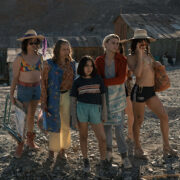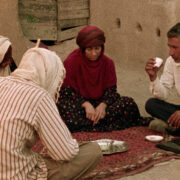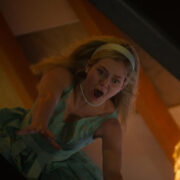The 20th Annual Animation Show Of Shows: 3 Oscar Shortlist & A Variety of Characters Makes For One Outstanding Showcase
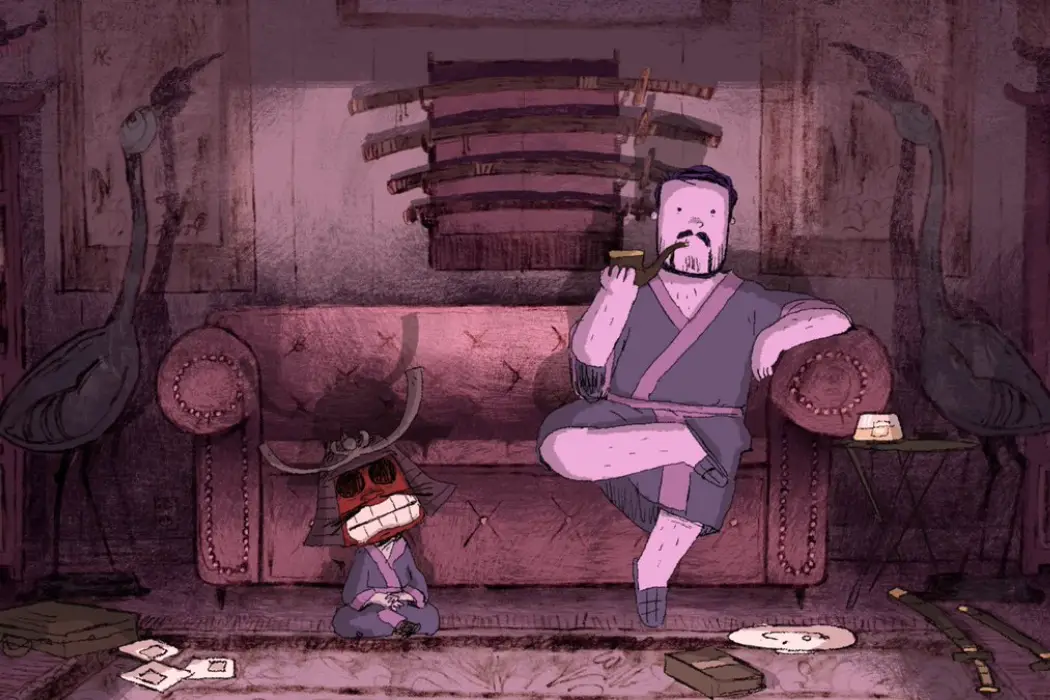
Stephanie Archer is 39 year old film fanatic living in…
Short films have a unique ability to strike the heart with impactful and resonating stories in a tight timeframe. In just mere minutes, viewers can experience a cathartic experience in a wholesome encapsulation. Animated shorts, with at times their personified creatures, had a deeper ability to strike at the hearts and minds of viewers, its relationship to childhood and a vail of innocence allowing us to let our guard down and welcome the unexpected.
It is for this reason the animated shorts are a personal favorite of mine, and the reason I jumped at the chance to cover the Show of Shows. For the 20th Annual Animation Show of Shows, 15 animated films were selected, curated to form this captivating showcase – with three currently on the shortlist for the 2019 Oscar Animated Shorts Nominations.
The Green Bird – Maximilien Bougeois, Quentin Dubois, Marine Goalard, Irina Nguyen-Duc and Pierre Perveyrie (France)
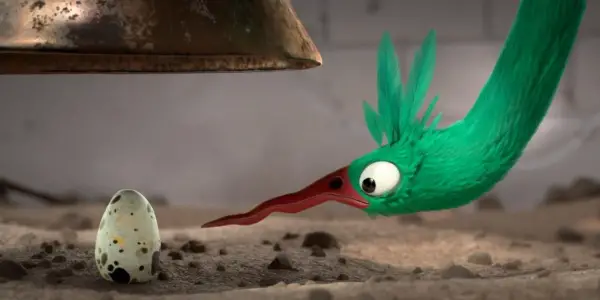
What a way to kick off the 20th Annual Animation Show of Shows. The Green Bird was a humorous take on a mother protecting her egg against all forces of nature – and not without some mishaps along the way. What starts with the annoyance of a small fly, turns into an epic battle of strength and wit against an immovable force of nature.
The green bird, with human-like legs, while trying to silence a nagging fly, realizes that she has laid an egg. While immediately feeling the urge to protect it, the bird is faced once again with the nagging fly, destroying her refugee in her mission to devour it. Left out in the open, the green bird finds sanctuary in an old abandoned and rundown church, nestling safely in a sandy patch beneath the steeple. That is until a clap of thunder scares the bird, lightning striking the church, causing the bell to fall safely over the egg. Without strength and wit enough to retrieve it, a series of attempts results in an ill-fated misfortune – all while the fly buzzes in and out of each obstacle.
Devastated, the green bird lashes out in rage and agony, its cry of heartbreak over its crushed egg agonizing. Even though the cry has been fairly the same the entire short with few variations, we as viewers put emotion and value on each scene this cry is placed in, imbuing the cry with personified emotion. As the bird lays over the bell distraught, another clanking is heard, this time from the chick she had thought was lost. As they cry to one another, the fly buzzes once more – until it is caught by the young chick.
The Green Bird was an amazing short. Set in a desert setting, it really made the bird standout front and center – there was no way to miss the attention to detail that went into the creation of the green bird. The sounds and music excel at elevating the short. The upbeat vocals blend with the action, bringing it to new heights and interlacing tension. The fly adds an interesting addition as well. While the short could have simply stuck with the story of a mother protecting her young, The Green Bird went further than that, giving meaning to the smallest of details. Through the fly, we as viewers can understand the importance of the passing of knowledge to our young, and the importance of that young building upon the knowledge they are given (or born with). While the mother was unable to get the fly, the child was – displaying an evolution between generations.
One Small Step – Andrew Chesworth and Bobby Pontillas (US)
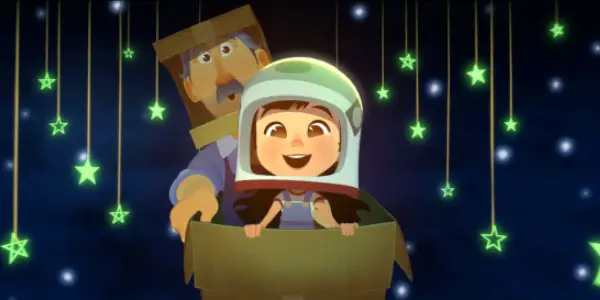
One Small Step was the first within the showcase that is currently on the short list for the 2019 Oscar animated shorts nominations – and it is clear to see why. From beautiful execution to a heartfelt story, this one has it all. Before embarking on this one, however, grab some tissues.
One Small Step is a look at the depths of a father-daughter relationship – as well as the relationship between children and their parents in general. We are quickly introduced to Luna and her father. With a deep passion for space exploration, Luna’s father shares in her adventures and nurtures them – crafting her a pair of space boots for her birthday. As imagination turns into real life, Luna grows, childish fantasy turned into future goals – her father always in the shadows doing what he can to help her succeed.
As they both grow, Luna continues to push forward in her studies even in the face of failure, while her father continually mends her shoes after she has gone to study or to bed. Sadly and eventually, Luna begins to break away from her father, as all children do, until one day she returns home and her father is no longer waiting for her at the kitchen table. Wallowing in sorrow and regret, Luna turns her back on the dreams she built with her father about becoming an astronaut, ripping posters and crying along in the dark. Cue the tears, and grab the tissues – there is more to come.
As Luna cleans up their garage, she comes across a box of all her old shoes that her father had saved. The building blocks to her future and one of the only things he could fix for her as she worked to achieve her dreams, she finds new resolve to continue and become the person her father believed she could become. As parents, we are the soles on our children’s shoes, giving them the support and foundation to survive in the world. We mend their wounds and help pick them back up, encouraging them to push further and reach their dreams.
Grands Canons – Alain Biet (France)
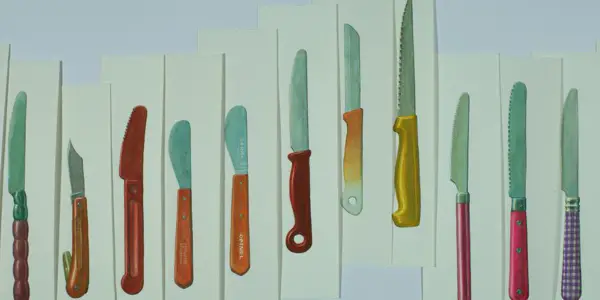
The mundane is so overlooked, and that is one thing that makes Grands Canons so beautiful. Starting off, you find yourself questioning not only about where this short could possibly be going, but also whether this actually qualifies as an animated short. Well, hold on because the wait is worth it.
Peaceful and serene, Grands Canons begins with an artist tracing and subsequently painting a picture of a pencil. The craft and care given to the painting is meticulous and exquisite – and it lends to an appreciation that may not have existed before – an appreciation you will find coming to fruition as the short continues.
As the artist completes his drawing, viewers are thrown into a symphonic showcase, the image of the pencil transforming into other pencils, markers and crayons. From here, it is transferred further – light bulbs, appliances, cleaner products – image after image of items in our daily lives. These seemingly mundane items of everyday life are strewn together to create something extravagant. There is beauty in the mundane.
The editing is phenomenal and the timing impeccable. You will find yourselves mesmerized by the fluidity with which each image blends into the next, finding a new appreciation for more than one art form. Speaking of the art, each of the paintings shown, and there are a lot, were hand drawn by the artist we initially see drawing the pencil. A dedication to a craft that has found its medium of showcase.
Barry – Anchi Shen (US)
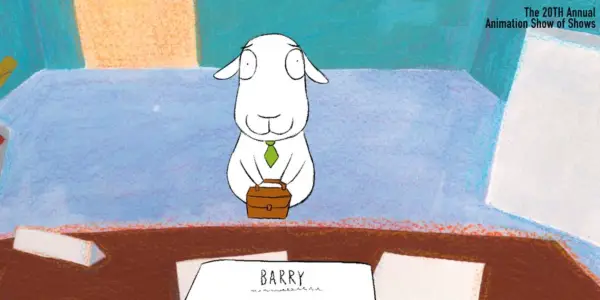
Animated shorts seem as though they will be an entertaining time, and they are, but many times they are so much more than entertainment. Barry is one of those animated shorts that proves this. A goat who aspires to be more than a grazer has worked to achieve the title of Doctor (and that is MD of humans I might add). Yet, try as he might, no one will hire him because he is a goat.
Pleading with a Human Resources hiring representative, he talks of how his mother and father sold themselves to earn the money needed so he could pursue he dreams of becoming a doctor and the fears that surround his future – did his parents do this in vain? Moved by the goat’s plea, the HR personnel makes a call to authorize this unusual hire, much to Barry’s delight. Yet his joy is quickly squelched as he is handed a mop and broom and demeaned to nothing more than a janitor.
Determined to prove himself, Barry interjects medically wherever he can, believing that if he proves his worth and intelligence, the doors will finally open for him. It backfires, however, his interactions cause for concern and expulsion from the hospital. Admitting to himself he was foolish to dream beyond his specie’s restrictions, Barry drops to his knees on the grass outside and begins to graze.
As he does, the doctors, who unlike the board and those of higher authority, have seen the good and change Barry has provided to all those around him, cry for him to stop, to never give up. To them he has proven his worth, and his mark will last a lifetime. Having solved cancer, he is to become a legend.
It is a very introspective look into our treatment of individuals in our society. We have preconceived notions of who should and shouldn’t be allowed to inhabit certain positions, thus limiting the advancements and opportunities for the future. The next scientific breakthrough could be locked within the mind of an individual who has been shorted the opportunities required to unlock this knowledge. By doing a disservice to these individuals, we are also doing a disservice to ourselves.
Super Girl – Nancy Kangas (US)
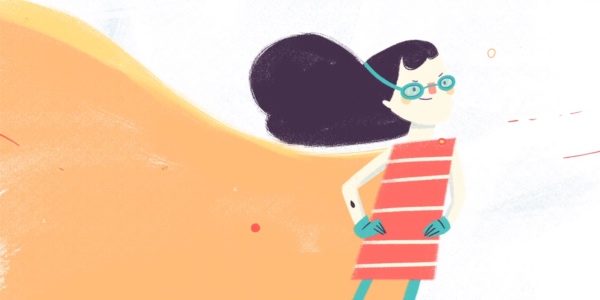
Supergirl was one of two animated shorts in the showcase based on poems written by children – both Bullets (which we discuss later on) and Supergirl are part of an 8 short film segment called Preschool Poets. A sweet short, accompanied by an even sweeter and innocent vice, Supergirl is in part both childish fantasy and an awareness of independence.
Broken into two parts, part one sees this young child want to fly high, and kick those who do wrong or try to do harm to her and others, a regular fantasy of many preschoolers: the desire for the impossible. At this age, there is a lesser awareness of what is real and what isn’t, but the freedom of the imagination is the strongest stimulant for a child, and the moment when many dreams are initially born.
Part two, is the acknowledgement of the future and more grown up; ideologies – primarily independence. She speaks of her love for ice, pretending to be frozen within. Why ice? Because ice does not make you do anything. I.e. Does not make you go to school, or clean your room. Ice is the future they are beginning to understand, beginning to desire. A drive is coming to life inside of them that will be a pushing force in their lives.
It is an interesting peek into the mind of a child, the evolving brain and viewpoint on the world as it goes from childish naivety, moving to an awareness of where they will be going. One day they will make their own decisions – possibly reaching the Supergirl state in adult form. It is an interesting moment in child psychology that many miss in real life.
Love Me, Fear Me – Victoria Solomon (Germany)
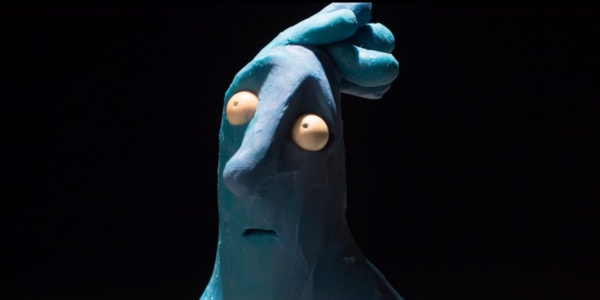
Love Me, Fear Me is a beautiful and mind-blowing showcase of Claymation talent. The melding and transitions between creatures, culminating in a chaotic mixing of colors, is delivered with perfection, and a standout in the medium.
What starts as a comedic performance, the audience laughing and applauding on cue, unexpectedly gives way to silence, the star lights turned off. The creature is left confused and lost in the darkness. Finding a new spotlight, it tries again to draw laughs from the crowd, but finds it is to no avail. The audience no longer finds humor in its act. So the creature adapts, changing itself and its performance into a sultry and seductive dance that entices the attention of the audience – and it works! Once again, it is the subject of their attentions. But only for so long.
Once again finding a new spotlight and failing to recreate its audience, the creature turns into a master of martial arts. While he gains the attention of the audience again, this time around is even shorter than the previous performances. Finding it must once again evolve, the experience of frugality is once again had – yet this time to no applause. This reinvention has not found its audience, and the artist, who had long lost its identity, is lost within itself. There have been so many modifications for the sake of the audience that it no longer knows itself. It is not until the creature sheds its personas that it can truly find itself and happiness.
It was interesting watching Love Me, Hate Me, as it is a reflection on the self-sacrifice some artists make in the name of fame and success, as well as speaks to the attention span and desensitization of the audiences they are constantly trying to win over. In the fight between winning and losing in art, it is when we lose ourselves that we are truly lost, and only in understanding who we really are can we find the success we truly desire.
Business Meeting – Guys Charnaux (Brazil)
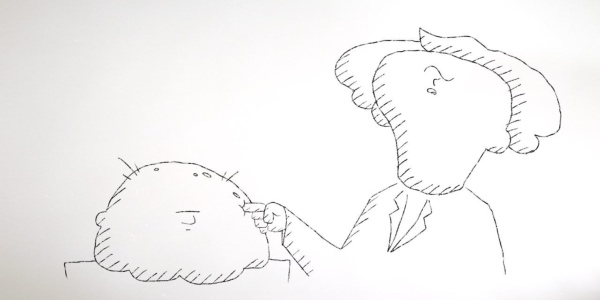
Watching Business Meeting, I found myself wondering about those that run corporations throughout the U.S., and the world. You imagine it being somewhat dry and bleak, but to see it displayed as such on screen is a different image altogether. Short and effective, Business Meeting gets its point across, utilizing simplistic drawings to accentuate the lack of originality and individuality of the room and its members.
Yet, as we close in on each member around the table, each person is different, communicating in a different language. There is individuality and difference between each person. Though as we go from person to person, the same line is repeated “I make ___ words my own”, the preceding individual’s name changed each time. While they look different and have different languages, they think the same and back up the person before them with no objection.
Corporate speak is not for the layman, and not for free thinkers either. It depicts butt kissers, supporting the person in from of them, who could be concluded as their superior. Patting each other on the back, this roundabout meeting ends with no advancement, no new ideas – just the same run around.
Flower Found! – Jorn Leeuwerink (The Netherlands)
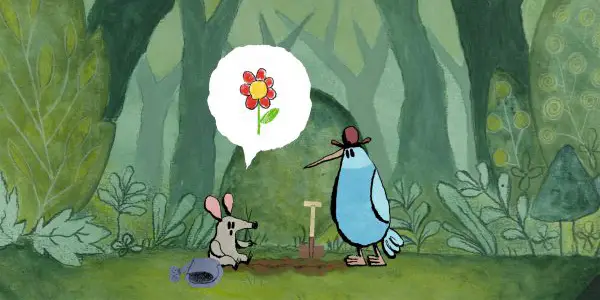
This was the most surprising of the bunch – its dark humor and grave conclusion unforgettable. What starts as an innocent search for a missing flower turns swiftly into a poultry-themed witch hunt, with guilt and false accusations left in its wake.
A field mouse, having returned from fetching water for its beautiful flower, is distraught and saddened to find that someone has dug it up and taken it during his absence. As he mourns the loss of this beauty in his life, he is greeted by a bird who vows to help the small mouse locate its precious flower. With nothing more than a description of a yellow center, surrounded by a circle of red petals, the search party of two expands as more of the forest’s wildlife join in the hunt. As they reach a small cottage, what appear to be petals peering just above the door turns out to be the head of the chicken – whose appearance, like the flower, has a yellow beak in the center surrounded by the chicken’s red comb.
While the mouse is saddened, the other animals are enraged. The chicken is quickly brought to trial to determine his nature – flower or chicken. Try as he might, the small field mouse is unable to convince the court and the jury that it is a chicken. The animals display their ignorance and resolve in their decision, and the chicken is beheaded. As the mouse solemnly carries the chicken’s head to bury it where the flower was once planted, viewers are left in shock – though with deep understanding of our culture.
Too often, we are swift to make decisions based on small bits of information – even if that information is found to be false. We are not easily swayed from our preconceptions of what a thing is and how the situation should go. Our rash judgments bring inexplicable harm to those who are innocent. We need to take the time to listen to all sides, even if we disagree. We need to strive to obtain as must information that is readily available to us, before making a final decision.
As the flower was marked with characteristics the chicken shared, he was automatically called a flower. By stereotyping based on what we look like, we are leaving guilt and false accusations in our wake. We condemn a race, gender or sexual preference into a category of unchangeable characteristics that continue to created a forced viewpoint. By not expanding our lines of thought, we are restricting and damaging the lives around us. Only by getting to know the person in front of us for who they truly are can we look beyond.
Bullets – Nancy Kangas (US)

One of the saddest trends I have begun to notice in film and television, is the depiction of the world our school children live in. This year’s film Eighth Grade was an eye-opening examination of the acceptance and desensitization of the world where violence in our school, particularly gun violence, has become such a norm. In this film, the students are practicing a “shooting drill” whereby they are told to run if in the halls is a shooter (after a shooting reenactment), and practice hiding under their desks if they are in their classrooms. The scene chalks itself up to nothing more than a fire drill. This is the world we live in, that we have begun to accept for our children.
Bullets was equally striking, as it is based off a poem by a very young child – a preschooler to be exact. This was truly sad and heartbreaking. The fact that children, small children, are writing in poetry the violence that has invaded their lives is heartbreaking. To hear the little voice recite the poem is equally heartbreaking.
The animation presented in the short depicts an equally angry and distracted world. As the child states “relax world”, viewers are shown couples fighting, people angry at their TV sets and corporate figureheads overlooking the city. “Relax bullets from guns, stop shooting people” is spoken as two seemingly teenaged boys walk up to the man, pointing their guns, those who had been distracted by hate and technology standing behind them. “Fire Eat Wood” as the short is engulfed by a ball of orange and yellow light.
What goes on in the minds of children these days? What do they fear and think about? If this poem is any indication, they think about a lot more than we are giving attention to. They see the world for all its anger and violence, the chaos of society unending. It is through their eyes we may truly see ourselves. “Relax world”.
A Table’s Game – Nicolás Petelski (Spain)
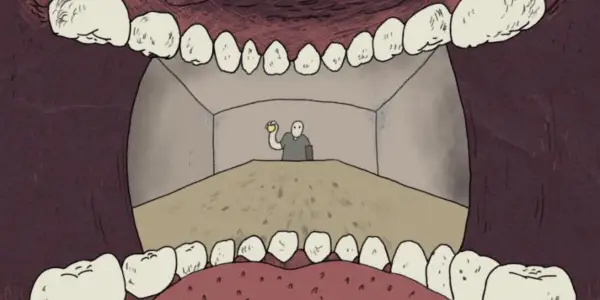
This was one of the most bizarre. While many of the shorts featured in this showcase are a little more easily understood, A Table’s Game took a bit more time. When I finally did, it was more obvious than I had originally thought. Patience – all things come to those who wait.
A Table’s Game is literally just that – a game played by two men, each on the other side of a table. They begin bouncing balls off the table, attempting to get it in the mouth of the other player. As they try time and time again, each of their failures is represented outside of their game, birds and a stadium. Try and try as they might, they cannot achieve their goal. Finally, exhausted and worn out, they notice there is one ball left in the box. Trying one last time, they succeed. Initially surprised themselves, they find gratification that they were able to win the game.
The tenacity and strive with which the players embraced their task, as well as the patience for success to be obtained, was what brought them to the finish line. It is an exercise in patience and determination. Just as they are about to give up, they try again, this final time being the one that put them all to rest. It is a lesson we should remember and can apply to our daily lives, and to the long term goals we are trying to achieve.
Carlotta’s Face – Valentin Riedl, Frédéric Schuld (Germany)
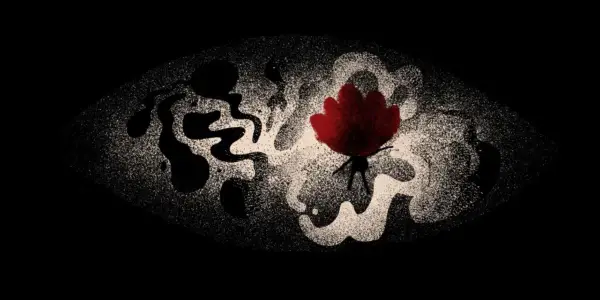
Animated shorts, as we have seen thus far, have the incredible ability to transcend childish natures and deliver messages behind their animated content. Carlotta’s Face is no exception. An eye-opening short, it brings awareness to a disability that many may have never heard of.
Carlotta’s Face is a narrated animated short, a small faceless red-haired girl making her way through a black and white landscape. Washed into an unrecognizable sea, the narrator describes her inability to see faces. As she speaks, the fluid waves begin to form a face, but not a human one. It is distorted with large lips and bulging eyes to the sides. We recognize it as a face, but not the identity of the creature in the picture – which in real life she has been asked to identify. This distorted image is to be how she sees a monkey.
Washed onto a shore, viewers will soon realize the rocks, only distinguishable by shape and size, are representative of the people around her she cannot identify. Like the rocks, they are faceless. The narrator continues to recall her childhood, the students she could not connect with as she could identify them, and the teachers who lacked understanding of her condition. They, like the children, bullied her with their ignorance and misunderstandings.
The short comes full circle with the revelation that Carlotta cannot see her own face. While she is lost within a world that does not understand her condition, she is also lost in herself, unable to see her own identity. She is just like the faceless rock on the beach. Yet, with time comes understanding and learning. Having read a book, Carlotta learns to draw her own face through her sense of touch, a tool that helps her find not only identify but a means to connect with the world.
Age of Sail – John Kahrs (US)
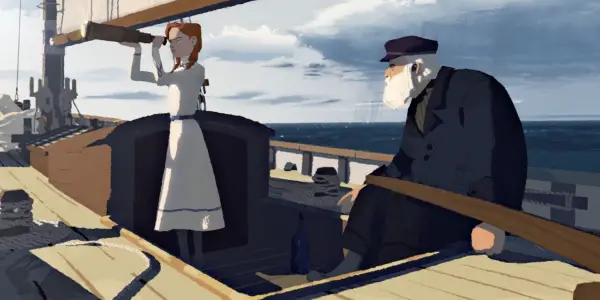
This was the second animated film in the showcase that has recently been announced to be on the 2019 Oscar shortlist for Best Animated Short. While the animation is a bit rough at times for me, seeming more of storyboard form than a finished product, its story and message shine beyond the visuals.
Age of Sail almost immediately gives off a Titanic-esque vibe. The steamers that pass the old man’s sailboat have the smoke stakes very similar (as was popular of the time), and the young girl he saves screams a younger version of Rose from James Cameron‘s Titanic. Her red hair and attire instantly draw callbacks to the classic film. This is where the comparisons conclude, however.
The old man is a sailer of the times before steamboats, when your mast and sail were the conquerors of the seas. Though as times have changed, the sailboat has been reduced to a leisurely activity, and not one to live by. Unable to change with the times and married to the sea, the old man has lost his resolve and fight. Unable to move forward with the changing times, he has decided to end it all.
Yet, when he saves the young girl who has fallen overboard, he finds that before he can end his life he must ensure the survival of hers. Seeing a boat just on the horizon, and with a little convincing, he throws himself back into the glory days, raising his sails and bringing his boat into glory one last time.
This is a lesson in life, in fighting to stay relevant – in never giving up. The world is constantly changing around us, and while we may remember the days of old fondly, there is a need to move forward with a necessity to never forget the past. When faced with actual death, outside of his control, the captain finds himself once more, fighting with the sea instead of the evolution of man’s machines. The manmade items around us will always change, but the elements we made them for, the ones we long to be with, will always stay the same.
Polaris – Hikari Toriumi (US)
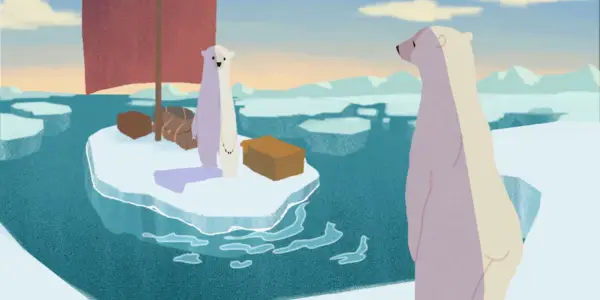
Polaris was a cute little animated short, reminding both sides of the coin of the relationship between a mother and her child – specifically her son. Ready to fly the nest, the young polar bear prepares his journey to venture out into the world. Preparing his iceberg for departure, the young bear says a warm goodbye to his penguin friends, each chirping their respective farewells. As he turns to his mother, however, he is more cold, denying a small box she has offered for him to take along his journey.
Where he had said goodbye willingly and intimately to his penguin friends, he is more cold with his mother. The young polar bear denies her request for a hug goodbye, quickly giving her a peck and setting off on his journey. As he begins to sail out of sight, the box his mother gave him begins to sink the iceberg, the only option to throw it overboard. Rations, pots, and hangers are all thrown carelessly into the ocean, until he stumbles on a night sky blanket, reminding him of the times he has spent with his mother.
He quickly dives back in to save the items, each of which represents a memory – memories the items represent for them both. As he walks back on to shore, he looks small again, having been humbled to his past, and found affection for the one whose memories he shares. Finally embracing his mother in a true goodbye, he ventures into the world.
It’s a sweet short, reminding parents that they are never truly forgotten, but also reminding children that they should never forget. As they grow older, they may bestow affections on those around them, embarrassed to do so for those closest, but they will never forget where they came from.
My Moon – Eusong Lee (US)
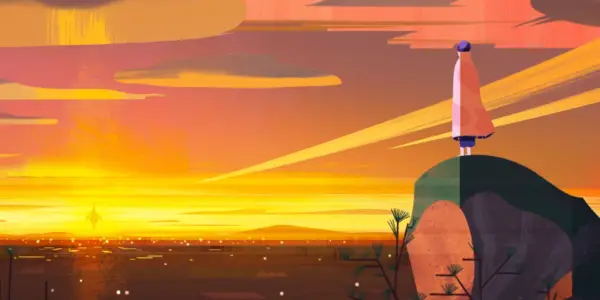
My Moon is a personified animated short that explains the relationship of the earth to the sun and the moon. It showcases each attraction as one within a relationship, with a brief understanding of what one does for the other, and the inability to live without either.
While the earth and the moon want to be together, the earth finds that she is more attracted to the sun. The sun is able to provide more for the earth than the moon can, and the attraction between the two is undeniable. When the moon is faced with accepting this reality, it abandons the earth, believing that making the choice for her would be a better option. Yet, as the moon disappears, so too does the beauty of the earth. The earth cannot live without the moon. Saving earth at the last minute from being engulfed in darkness, the moon promises it will always be there, looking from afar.
In real life there is a stranger attraction to the sun, we are ruled by its gravitational pull. We need its light to grow the planet life and food we need to survive. We need the vitamin D for growth. The earth would be dead without it. But we also need the moon, which is actually kept close by our gravitational pull. Even though we continue to keep the moon “coming back” we also need it for the functionality of earth as well. The tides, weather, so many things rely on the presence of the moon. We are all connected, and we are all dependent on each other.
Weekends – Trevor Jimenez (US)
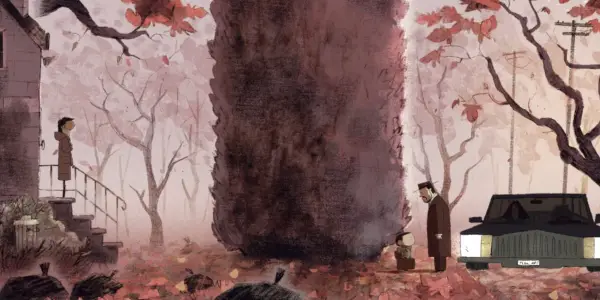
Our final short in the showcase is also the last of animated shorts to be announced on the 2019 Oscar Animated Short Shortlist – as well as the longest. At 15-mins, Weekends is a harsh look into the life of a child following the divorce of his parents.
As a young child, he does not notice the things we as adults will. Where he may see the dullness of life at home with his mother, we as viewers see the boxes on all over the house waiting to be unpacked, the brace around her neck and the instability of emotion, yet determination to survive as she immediately begins a new relationship (one that is short-lived as indicated by the candle above his head) and begins developing a new career. In contrast, we see the boy’s father on the weekends. Where the little child sees a carefree and highly invested father, we as viewers see a man who has never learned to grow up, who stimulates his child with his interests – many violent and not suited for children.
At the beginning, the young boy finds preference in his weekends with his father, finding he is more at home and accepted there, in contrast to his mother who is trying to discover her new place in the world. As his mother’s relationship blossoms, so too does the relationship with the boy and his father. Yet, as can be assumed, the father’s future will also find its own path, verging away from the one he shares with his son.
As he begins a new relationship, which quickly escalates into more, the father begins to break away from his son, their shared experiences becoming fewer and fewer. Selling his apartment, following his abrupt marriage to his new lady, viewers can surmise the father is always as he has been, compulsive and unpredictable. Beginning his new life, he leaves his boy behind, never returning for their scheduled weekends.
Yet, as we expect the boy to be permanently distraught, we are instead given a glimpse into the growing relationship with his mother, their experiences something they share together. Turning their house into a home together, celebrating the academic accomplishments of the mother together and finding their own way of enjoying each other’s company. While the mother had struggled during her time following the breakup, she was always there for the boy – something he understands at the end.
Conclusion
The 20th Annual Animation Show of Shows is an exquisite and engaging showcase of some of the best animated shorts from 2018. Curated with precise selectivity, this showcase has given a platform to the animators, writers and directors, a moment to shine in the spotlight and moment to reach audiences alike. With excitement and satisfactions as the Show of Shows ended, the anticipation for next year’s line up begins.
Have you seen any of these animated shorts? What was your favorite? Let us know in the comments below!
Does content like this matter to you?
Become a Member and support film journalism. Unlock access to all of Film Inquiry`s great articles. Join a community of like-minded readers who are passionate about cinema - get access to our private members Network, give back to independent filmmakers, and more.








